Have you ever had live creatures in your classroom? There is something quite magical about having a living, breathing part of nature in the classroom to inspire some deep thinking. Beyond the obvious scientific connections, having live creatures in the classroom also provides opportunities for social development around respect, responsibility, care-giving, and self-regulation. Over the years I’ve had many insects, amphibians, and animals come through my door but butterflies are definitely my favourite. The whole process of watching and waiting for metamorphosis to occur provides endless opportunities for observations, predictions, hypotheses, and of course, lots of excitement!
This inquiry project turned out to be quite all-encompassing and there is a lot I want to share here. This post will be mainly photo based, with some captions for the photos to describe what we were doing. If you have any questions, please don’t hesitate to ask!

Our caterpillars on the day of their arrival. We ordered our live caterpillars (Painted Lady Butterflies) from Boreal Science.

E.A. thought our caterpillars should have names – here, she made name tags for two: “Zigzag” and “Stripey.”

Our literacy connection for the start of this inquiry was The Very Hungry Caterpillar by Eric Carle. Here, F.S. records a shadow-puppet retelling of the story on the iPad.
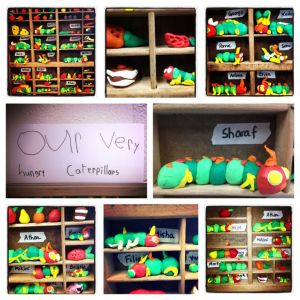
We represented each phase of the butterfly life cycle through an art piece. Here is our collaborative art piece for the caterpillar, based on Eric Carle’s famous story.

Racing caterpillars at the math centre. The children negotiated the length of the course and recorded the results of their races.

We found this idea on Pinterest – recording the growth and change of our butterflies. We kept this record on the SMARTBoard.

Art and Fine Motor Instruction: learning how to draw a butterfly. Much of this lesson was dedicated to symmetry.

Our See, Think, Wonder graphic organizers were available throughout the entire inquiry. This one says, “I see the butterfly has spots. I think it is camouflage. I wonder how the butterflies get their designs.”

One of our main questions was “how can we care for our caterpillars/butterflies?” This led us to think about how to create a habitat for the butterflies where they could thrive while we had them indoors. The children recorded their ideas on butterfly habitat planning sheets and gathered their materials in our outdoor classroom.

Our representation of the chrysalis stage: creating a chrysalis out of papier mache. The children added finer details with permanent markers when their work was dry.
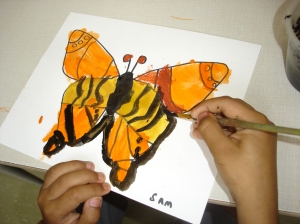
Representing our butterflies with beautiful watercolour paintings. The children worked very hard to create symmetrical designs on the butterfly wings.
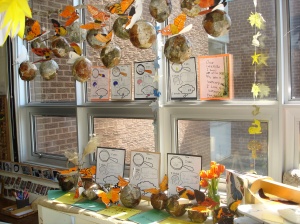
Documentation of our learning. We layered the children’s work in a display that captured not only the growth and change of the caterpillars but the growth and change of our own learning and understanding.

We celebrated the end of our learning journey with a butterfly release party in our outdoor classroom where the children sang songs and talked about their wishes for our butterflies as they flew into nature.


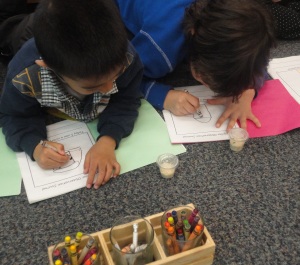
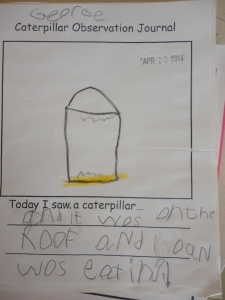
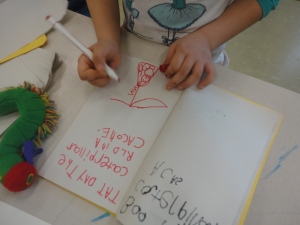


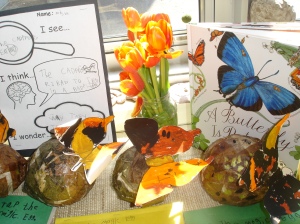

I love your blog! We are just starting our butterfly inquiry and your blog has been so helpful. I am wondering, could you give more detail about the racing caterpillars in your math area? What is the goal? What are the students measuring? We are getting our caterpillars next week and would love to implement as many caterpillar things as possible! Thanks!
Hi Mindi! Thank you! For racing caterpillars we were working on ordinal numbers (first, second, third…) and data management (the students recorded the results of their races on clipboards). We also had the students create their own race course using tape (a starting and finish line) which they labelled. They had to negotiate the length of the course and spent some time figuring out how far the caterpillars could actually travel (measuring). I was also looking for the children to self- regulate turn taking in the various jobs that were required for this activity. Hope that helps!
Wow that sounds fantastic! I really appreciate the explanation, it is even more than I had imagined. Thanks!
Pingback: Butterfly Inquiry: Inspiring Young Authors with Tap the Magic…Egg? | The Curious Kindergarten
Your blog is incredible! Thank you so very much for sharing. Are you required to write inquiry-based lesson plans and if so is there template that you use?
Hi Wendy! Thank you! I am not required to submit inquiry based lesson plans. I currently do not have a format that I am 100 percent thrilled with so I end up writing my plans in a notebook. It’s definitely something I’m looking to create in the future.
Hello dear I love your blog and I decided to follow you. You have amazing activities and provocation. I teach kindergarten also. Please let me know how to order for butterfly inquiry kit. please reply me soon, thanks a lot.
Love, shakila
shakilaathar@yahoo.ca
Hi! I loved this blog post! We are doing butterflies next week so I’m trying to get some inspiration! I was wondering how you attached the butterfly painting/chrysalis craft to the string? I’m trying to figure out the best way to hang mine too! Thanks!
Hi Rachel! Thanks! We glued small clothes pins to the back of the butterflies and clipped them onto the chrysalises. I believe we tied string around small paper clips to hang the chrysalises on the branches. Hope that helps!
I love how you recorded the growth and change of butterflies on a calendar template. I’ve looked everywhere on Pinterest and cannot find something similar. Would you be able to provide a link and/or more details? Much appreciated!
Thanks! I’m sorry I don’t have a template for that actually. I used SMART Notebook software for the calendar template and just dragged the photos on to show the changes in the caterpillars. I can’t remember if I made the calendar myself or used a template in the software. You could always make a PDF file of a calendar and then drag and drop pictures onto the caldendar days if you’re using a projector. Otherwise, you can do a low tech version by making a calendar on a cork board, white board or poster board and having the children add photos to each day. Just some suggestions. Hope that helps!
Hi, I love everything on your blog! I’m just wondering what material you used for the caterpillar sculptures, and where do you get it?
Thank you! That is plasticine or modelling clay. I actually got mine through the school board consumable catalogue. You can also find big bricks of it at the Dollarama in the craft section. They also sell packs with small sticks in a selection of rainbow colours. Hope that helps!
Thank you for sharing, I always find myself back on your page 🙂
You are welcome! Thanks for coming back! 😃